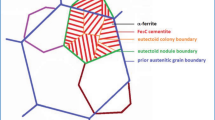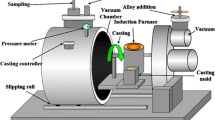Conclusions
-
1.
Raising the Mn concentration of low-pearlite steel from 0.4 to 1.8% leads to a considerable increase in strength (Δσb = 20kg/mm2, Δσb = 16kg/mm2), the elongation remains unchanged (δ=32%), and the reduction in section increases (Δψ∼10%).
-
2.
Alloying of low-pearlite steel with 0.4−1.5% Mn substantially improves the work of crack propagation in the ductile range (Δa p=7 kg-m/cm2) and shifts the ductile-brittle transition temperature to the range of negative temperatures\(\left( {\Delta T_{cr}^{a_{P_{2.0} } } = - 35^ \circ C} \right)\). The value ofa p increases with up to ∼2% Mn as compared to the steel with 0.4% Mn.
The percentage of ductile components in the fracture remains practically unchanged with the addition of up to 1.5% Mn, but decreases with larger amounts of Mn.
-
3.
The work of crack initiation increases substantially (by ∼8 kg-m/cm2) for the steel with 1.3–2.3% Mn as compared to the steel with 0.4% Mn.
-
4.
The strength of low-pearlite steel can be improved by alloying with up to 2% Mn, in which case σb ∼ 60 kg/mm2, σT = 43 kg/mm2 the work of crack initiationa i∼9 kg-m/cm2, and the work of crack propagationa ductilep ∼7 kg-m/cm2.
Alloying of low-pearlite steel with 1.5% Mn results in the highest resistance to crack propagation (a p∼14 kg-m/cm2).
Similar content being viewed by others
Literature cited
I. Rinebolt and W. Harris, TASM,43, 1175 (1951).
Ya. E. Gol'dshtein, Low-Alloy Steels in Machine Construction [in Russian], Mashinostroenie, Moscow (1968).
W. Duckworth et al., J. Iron Steel Inst.,203, 1108–1114 (1965).
J. Irani et al., in: Strong Tough Structural Steels, London (1967), pp. 110–122.
M. N. Georgiev et al., "Effect of carbon and boron on the ductile characteristics of low-alloy normalized steel," in: Progressive Methods of Heat Treatment and Chemicothermal Treatment [in Russian] (1973), pp. 5–10.
B. A. Drozdovskii and Ya. B. Fridman, Effect of Cracks on Mechanical Properties of Structural Steels [in Russian], Metallurgizdat, Moscow (1960).
M. N. Georgiev, M. P. Anuchkin, and V. A. Dogadaeva, "Ductile characteristics of steel 17GS," Metal. i Term. Obrabotka Metal., 2, 63–65 (1968).
N. J. Petch, "The ductile to brittle transition in α iron," in: Atomic Mechanism of Failure [Russian translation], Metallurgizdat, Moscow (1963), pp. 69–84.
Additional information
Central Scientific-Research Institute of Ferrous Metallurgy. Translated from Metallovedenie i Termicheskaya Obrabotka Metallov, No. 11, pp. 8–10, November, 1974.
Rights and permissions
About this article
Cite this article
Popova, L.V., Zikeev, V.N. Properties of low-pearlite steel with manganese. Met Sci Heat Treat 16, 913–915 (1974). https://doi.org/10.1007/BF00663793
Issue Date:
DOI: https://doi.org/10.1007/BF00663793




